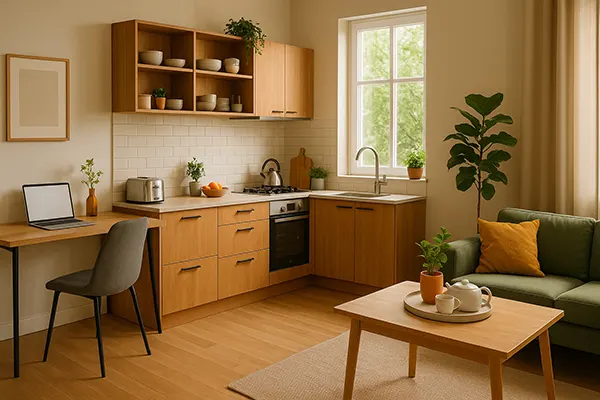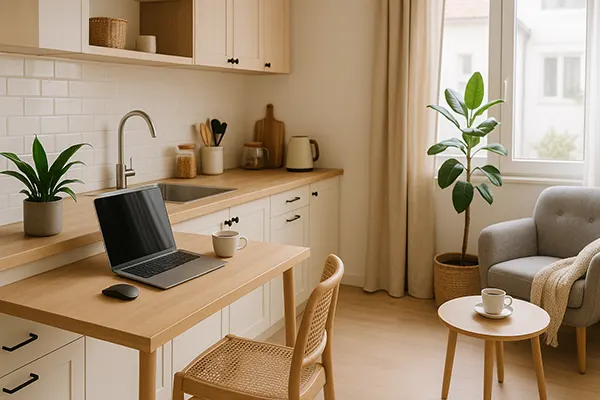
Organising a Multifunctional Kitchen: Turning Your Cooking Space into a Work and Relaxation Corner Without Renovation
Modern kitchens are more than just places for preparing meals. They are the heart of every home — where family conversations, creative ideas, and quiet moments often happen. In 2025, the trend of transforming small or traditional kitchens into multifunctional zones continues to grow. Without spending on renovation, you can combine a practical workspace and a relaxation area with smart planning and minimal effort.
Space Zoning and Ergonomic Design
The first step in creating a multifunctional kitchen is to define zones for different activities. For example, one area can be used for cooking, another for work, and a small corner for coffee breaks or relaxation. Instead of walls or partitions, use visual accents like lighting, carpets, or furniture arrangement to separate these areas.
Try adding a compact desk or bar counter near a window — it can easily serve as a place for working on a laptop during the day and a cosy dining spot in the evening. Proper zoning also means good ergonomics: everything should be within reach, without cluttering the space.
Lighting plays a key role. Combine functional task lighting above the countertop with warm ambient light for relaxation. Use dimmers or adjustable lamps to change the mood of the space depending on the activity.
Smart Furniture and Compact Storage
Modern solutions allow you to create multifunctionality without sacrificing comfort. Choose foldable or extendable tables, chairs that stack easily, and modular furniture that adapts to your needs. Many brands now offer transformable furniture designed for small urban apartments.
Storage should be both aesthetic and functional. Use vertical space — shelves, wall-mounted racks, and magnetic holders for utensils free up countertop space. Decorative baskets and containers help maintain order and add charm to the overall look.
It’s also worth considering furniture with hidden compartments — for example, a bench with internal storage for textiles or kitchen accessories. This makes it easier to keep the kitchen tidy while providing additional seating for guests.
Combining Functionality with Comfort
A multifunctional kitchen should not only be practical but also pleasant to spend time in. Add soft textures such as rugs, cushions, or curtains that soften the visual lines of the furniture. These details make the space warmer and more homely, especially when you’re switching from work mode to relaxation.
If possible, incorporate natural elements — plants, wooden accents, or linen fabrics. These details contribute to emotional comfort and improve air quality. A small herb garden on the windowsill not only decorates the kitchen but also provides fresh ingredients for cooking.
Music and aroma also influence the atmosphere. Consider installing a compact speaker system or diffuser with essential oils to make your multifunctional kitchen not just a working and cooking area but a truly inspiring space.
Creative Use of Decor and Colours
Colour zoning is a powerful tool for creating multifunctional spaces. Use contrasting tones to define different zones — for example, neutral shades in the work area and warmer tones in the relaxation corner. This technique visually separates the areas without physical barriers.
Artwork, photographs, or wall panels help personalise the space. Even small details like colourful cups or decorative trays can refresh the kitchen’s look. In 2025, natural materials, earthy tones, and minimalist Scandinavian-inspired designs are particularly popular.
Try experimenting with lighting temperature — cooler tones for focused tasks and warmer lights for relaxation. This subtle shift changes the perception of the space and enhances its versatility throughout the day.

Technology and Smart Organisation
Modern kitchens increasingly integrate smart technology that supports a multifunctional lifestyle. Wireless charging stations, Bluetooth lighting control, and compact smart devices make it easy to balance work and home life. Even a tablet stand can turn your kitchen into a home office within seconds.
Smart storage systems, such as pull-out organisers or adjustable drawers, help use every centimetre efficiently. Appliances with dual functions — for example, ovens with steam features — save both space and time, making everyday routines easier.
Energy-efficient appliances and LED lighting not only reduce electricity bills but also align with the sustainability trends of 2025. Combining technology with thoughtful organisation allows you to create a multifunctional kitchen that is both modern and comfortable.
Maintaining Order and Atmosphere
Even the most well-designed multifunctional space requires daily upkeep. Develop simple habits — cleaning surfaces immediately after use, putting items back in place, and avoiding unnecessary clutter. These actions keep your kitchen functional and welcoming.
Use small organisers for cables, documents, or stationery if you work from your kitchen. This ensures the transition between work and household activities remains seamless and stress-free. A tidy environment supports focus and creativity.
Finally, don’t forget about atmosphere. Candles, music, and soft evening light turn your kitchen into a sanctuary for relaxation. The harmony of order and aesthetics makes your multifunctional kitchen a true reflection of a modern lifestyle in 2025.
